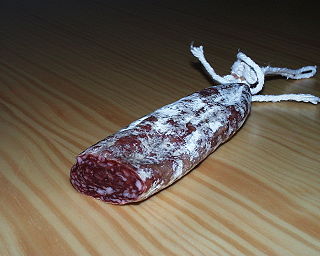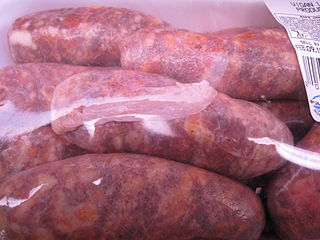Related Research Articles

A sausage is a type of meat product usually made from ground meat—often pork, beef, or poultry—along with salt, spices and other flavourings. Other ingredients, such as grains or breadcrumbs may be included as fillers or extenders.

A blood sausage is a sausage filled with blood that is cooked or dried and mixed with a filler until it is thick enough to solidify when cooled. Most commonly, the blood of pigs, sheep, lamb, cow, chicken, or goose is used.

Chorizo is a type of pork sausage originating from the Iberian Peninsula. It is made in many national and regional varieties in several countries on different continents. Some of these varieties are quite different from each other, occasionally leading to confusion or disagreements over the names and identities of the products in question.

Longaniza is a Spanish sausage (embutido) similar to a chorizo and also closely associated with the Portuguese linguiça. Its defining characteristics are interpreted differently from region to region. It is popular in the cuisines of several regions of Spain, Argentina, Uruguay, Puerto Rico, Dominican Republic, El Salvador, Guatemala, Mexico and Chile. In the Philippines, it is called longganisa and has hundreds of variants with different vernacular tastes and forms due to the 144 ethno-linguistic groups of the archipelago.

Embutido, or embotido, is a Philippine meatloaf made with ground pork and stuffed with hard-boiled eggs and sliced ham or various sausages. It is traditionally wrapped in aluminum foil and steamed, though it can also be baked.
Alaminos longganisa, also known as longganisa Pangasian, is a Filipino pork sausage originating from Alaminos, Pangasinan. It is a type of de recadolongganisa. It is made with ground lean pork, ground pork fat, brown sugar, coarse salt, saltpeter, black pepper, vinegar, and garlic in hog casings. It is typically bright yellow or orange due to the use of achuete seeds.

Vigan longganisa, also known as the Ilocano longganisa, is a Filipino pork sausage originating from Vigan City, Ilocos Sur. It is a type of de recadolongganisa. It is made with ground lean pork, ground pork fat, brown sugar, garlic, onions, bay leaves, soy sauce, vinegar, black pepper, and salt to taste in hog casings. Chili flakes may also be added. The sausages are celebrated in an annual "Longganisa Festival" in Vigan City.

Chorizo de Cebu, also known as longganisa de Cebu, is a Filipino pork sausage originating from Cebu. It is a type of hamonada (sweet) longganisa. They are distinctively red in color due to the use of achuete seeds. Each link is also usually spherical in shape. It is made from ground lean pork, ground pork fat, salt, saltpeter, sugar, anise liqueur (anisado), paprika, black pepper, garlic, and chilis to taste in a hog casing. It can also be made without the casing. They are usually fried or grilled and eaten with white rice, puso, or garlic rice for breakfast.
Chorizo negrense, also known as chorizo de Bacólod, is a Filipino smoked pork sausage originating from Bacolod, Negros. It comes in two flavors: hamonado (sweet) and recado (garlicky). It can be prepared smoked in a casing, or prepared fresh without the casing. It is made with ground pork, vinegar, garlic, calamansi, soy sauce, black pepper, and coarse salt. Sugar is added to the hamonado version.
Longganisa de Guinobatan is a Filipino pork sausage originating from the town of Guinobatan in Albay, Philippines. It is a type of de recadolongganisa. Each link is typically only 2 inches (5.1 cm) in length. It is made from lean pork, pork fat, salt, sugar, garlic, saltpeter, and black pepper. Unlike other Philippine sausages, the meat is uniquely chopped by hand. The dish is celebrated in the annual "Longganisa Festival" of Guinobatan.
Cabanatuan longganisa, also known as batutay, bototay, or batotay, depending on the municipality, is a Filipino beef sausage originating from Cabanatuan in the province of Nueva Ecija. It can be served sweet (hamonado), garlicky, or "skinless". It is celebrated in the annual "Longganisa Festival" of Cabanatuan.

Calumpit longganisa, also known as longganisang bawang, is a Filipino pork sausage originating from Calumpit, Bulacan, Philippines. It is a type of de recadolongganisa. It is made with lean pork, pork fat, garlic, bay leaves, brown sugar, soy sauce, vinegar, salt, black pepper, paprika, and optionally, chili.

Pampanga longganisa is a Filipino pork sausage originating from the province of Pampanga. It is a type of hamonado (sweet) longganisa. It is typically longer and thinner than other Philippine sausages. It is made with pork, garlic, brown sugar, black pepper, coarse salt, and vinegar. It can be prepared with or without the casing. It is typically dyed orange or red with achuete seeds. It is the most common sweet-type longganisa eaten throughout the Philippines, since it is commercially mass-produced.

Lucban longganisa is a Filipino pork sausage originating from Lucban, Quezon. It is a type of de recadolongganisa. It is characterized by its use of oregano and its garlicky and sour taste. It is made with lean pork, pork fat, coarse salt, garlic, oregano, paprika, sugar, and vinegar. It can be prepared with or without the casing.
Tuguegarao longganisa, also known as the Ybanag longganisa, is a Filipino pork sausage originating from the Ybanag people of Tuguegarao City, Cagayan. It is a type of de recadolongganisa. It is made with coarsely ground pork, black pepper, garlic, coarse salt, and cane vinegar in hog casings. It is typically dyed orange with achuete oil.

Chicken longganisa is a Filipino fresh sausage made with minced chicken meat, garlic, onion, soy sauce, muscovado sugar, salt, vinegar, and black pepper. Vegetable extenders can also be added like carrots, turnips, or jicamas. It is sold as a healthier alternative to other kinds of longganisa. It is usually prepared without the casing ("skinless"), and is molded into shape with the use of wax paper.

Guagua longganisa, also known as Candaba longganisa, is a Filipino pork sausage originating from the towns of Guagua and Candaba, Pampanga. It is a type of de recadolongganisa characterized by its salty and sour taste because of its heavier use of vinegar in comparison to other Filipino sausages.
Baguio longganisa is a Filipino pork sausage originating from the city of Baguio. It is a type of hamonado (sweet) longganisa.
References
- ↑ "How to Make Fish Longganisa". Business Diary Philippines. Retrieved 25 March 2019.
- ↑ Panggat, Erlinda B. "Product Innovations from Tuna and Milkfish Processing By-Products for Human Food Consumption". Food and Fertilizer Technology Center. Retrieved 25 March 2019.
- ↑ "Fisherfarms Garlic Fish Longaniza". Our Food Trip. Retrieved 25 March 2019.
